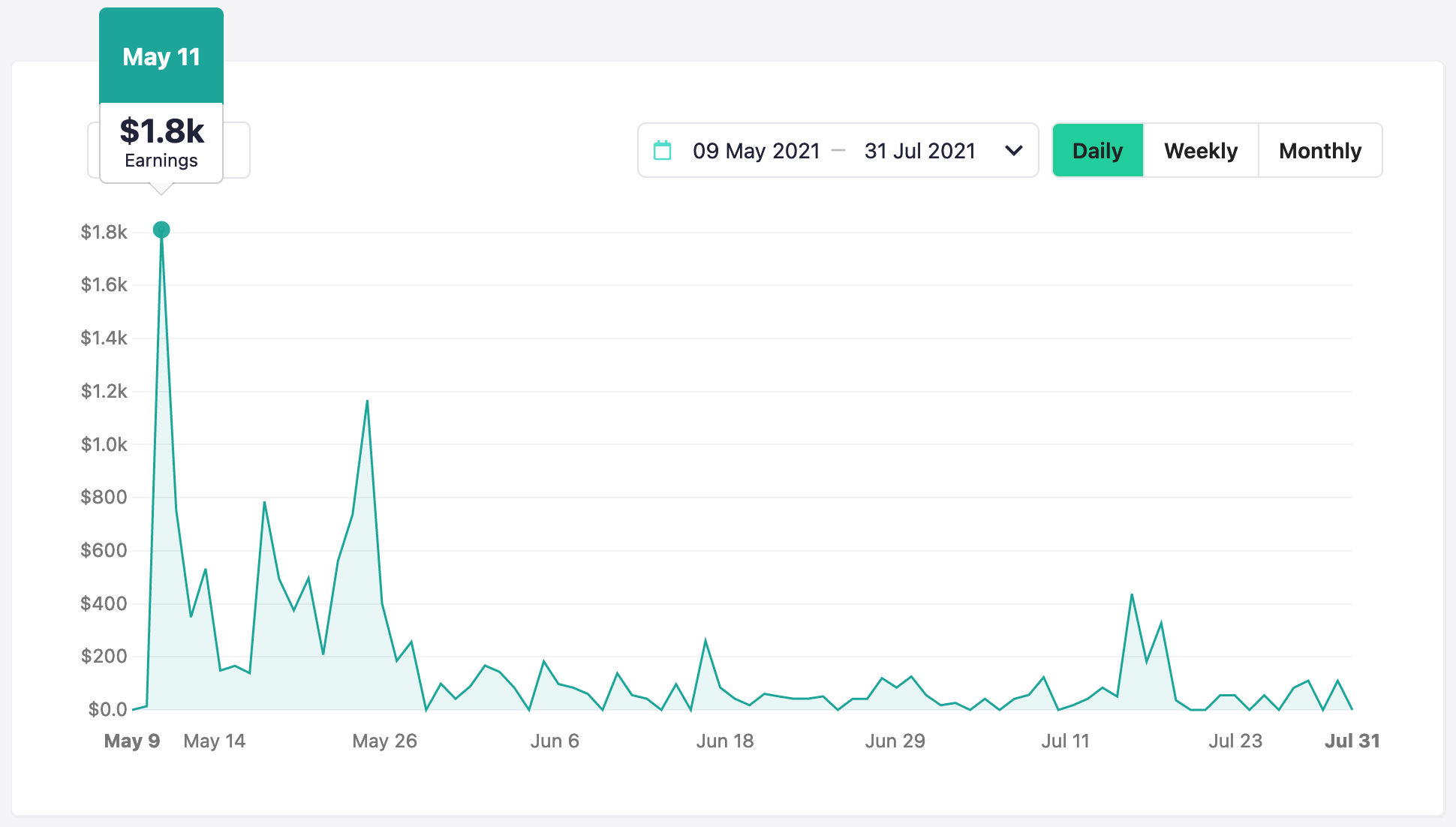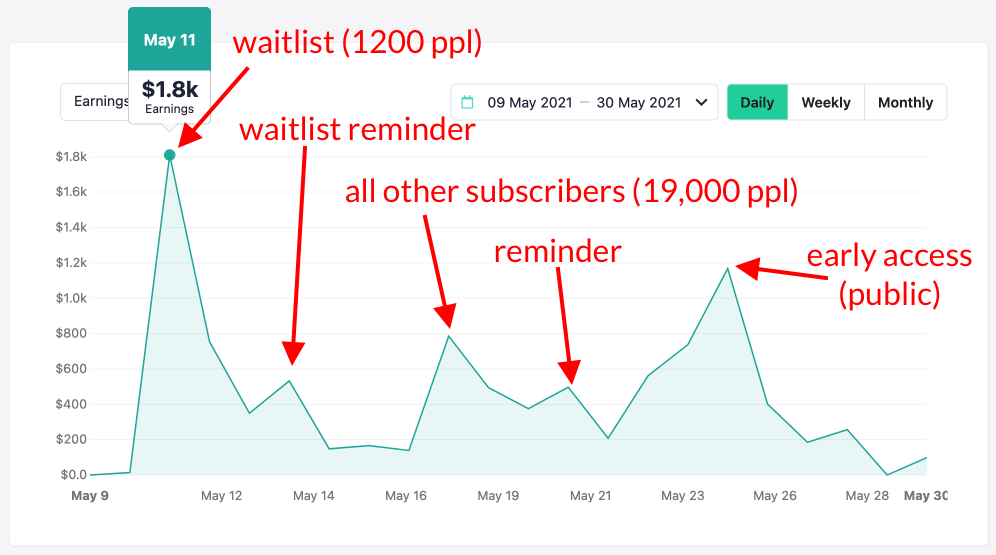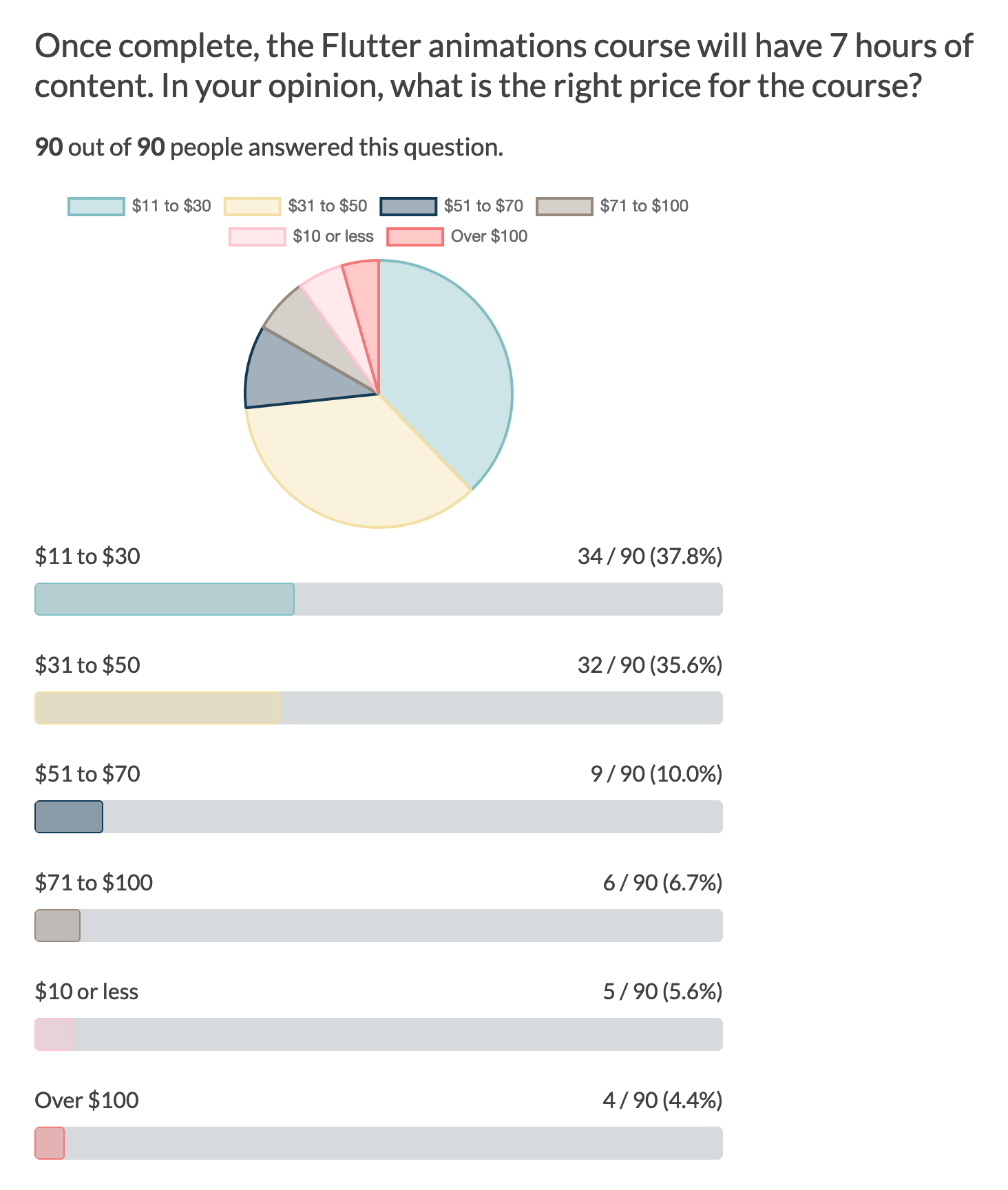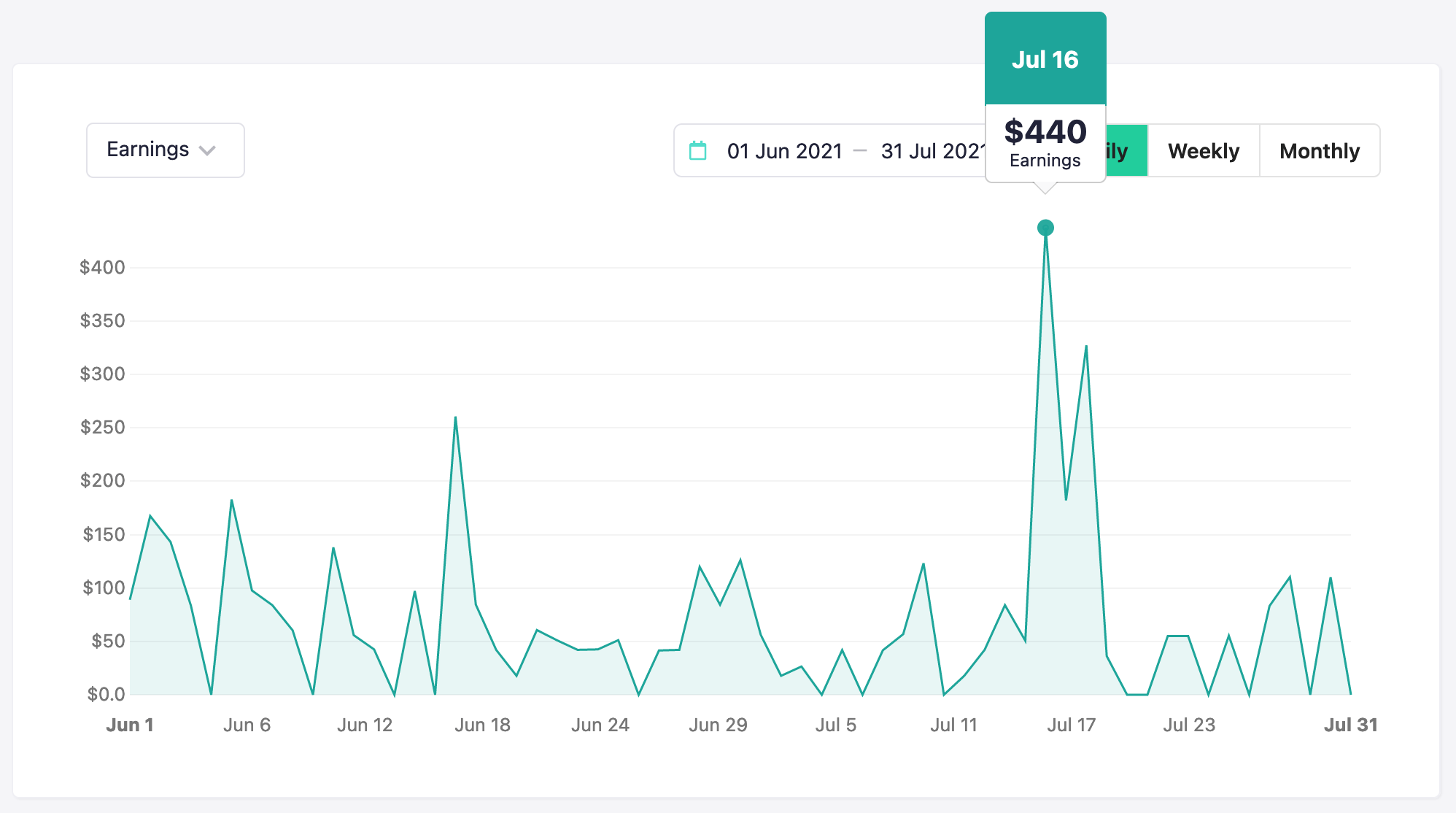Launching a course is a bit of a rollercoaster ride.
There are highs (launch spike yay 🥳) and lows (days without a single sale 😥). Navigating grinding through them can be exciting, stressful, and everything in between.
So here's a complete retro of everything I learned from launching my Flutter Animations Masterclass.
Key Highlights

Here are some of my insights:
- I earned $13,371 from the entire course launch (May to July)
- biggest spike: $1,800 on launch day ($2,500 in the first 24 hours)
- sales dropped sharply after the launch period
- a landing page with email signup goes a long way
- email marketing is king
Ready for all the juicy details? Here we go! 👇
Some Context
Since sharing my 2020 retro, I decided to become less reliant on Udemy as a marketplace, and start selling my new courses on Teachable.
Here are a few factors that contributed to this decision:
- Pricing: Udemy courses are often discounted, creating an expectation that courses should sell for $10-$15
- Platform lock-in: on Udemy, instructors don't have access to student emails
- Control: as my audience grows, I want more control over how I market/sell my courses and communicate with my students
In choosing Teachable, I knew I had all the marketing myself. So when I decided to launch a new course, I knew I had a big challenge ahead.
My course launch plan
Here's how I planned and executed my launch:
Validation
I had been tinkering a lot and wanted to create a course about Flutter animations for a while.
To validate demand for this topic, I posted this question on r/FlutterDev on Reddit:
This received 234 upvotes and 32 comments, telling me I was onto something.
I also sent a survey to all my 20,000 email subscribers, asking things like:
- how much experience do you have with Flutter and software development in general?
- what Flutter topics do you want to learn about?
- would you be interested in a Flutter animations course?
Out of 1158 respondents, 92.5% said they would be interested in my course, and 600 of them opted in to get updates.
Landing Page
On March 31st, I launched a landing page with a promo video and a sign-up form.
The page included a Flutter web demo of the main course project, which I had completed beforehand.
600 more people signed up over the coming month, growing my waitlist to 1,200 people.
Keeping the list "warm"
At the time I had been reading about the importance of keeping email subscribers "warm".
Since I was a few weeks away from the initial pre-sale, I decided to send weekly emails about my progress, along with some sneak peeks and useful tips about animations in Flutter.
Pricing
I put a lot of thinking into pricing. In the end, here's what I did:
- pre-sale to course waitlist: $30
- pre-sale to all my other email subscribers: $35
- early access price: $45
- full price: $59
Pre-sale & Early Access
Once 40% of the course content was ready, I started the pre-sale:
- Day 0 (May 11): first email blast to my waitlist
- Day 3 (May 14): reminder to my waitlist
- Day 7 (May 18): first email blast to my other subscribers
- Day 10 (May 21): reminder to my other subscribers
- Day 14 (May 25): public early access launch (Twitter, YouTube)
Here are the results for this period:

Highlights:
- Made $2,500 on the first 24 hours with an 8% conversion rate from 1200 people
- The second highest peak was $1,200 when I launched the course for early access
- I made $9,300 over the first three weeks
Pricing surveys
I also sent a short follow-up email to people who didn't buy the course to find out why. 199 people said it was too expensive.
So I decided to run another survey asking people what they thought was the right price. I sent this to everyone who already bought the course and got this:

The take-aways:
- 21% responded that they would pay $51 or more
- 57% responded that they would pay $31 or more
This was disappointing as I felt the full course was worth more than $50.
Interestingly, people in Europe said they were prepared to pay a higher price than those in North America, with all other continents far behind.
Holidays & Recharging Batteries
By the time I opened the course for early access, I had 60% of the content ready and 40% more to go.
Alongside other ongoing things in my life, the time leading up to the launch took a lot out of me and I was quite stressed out.
So I was very happy to put things on hold and go to Wales for a week. I had a truly amazing time there with my family, recharged my batteries, and got to count a lot of sheep:

During my time away from work, I made $900 in 9 days with zero promotion. I was pleased!
Completing the course
On my return, I got back to work, completed all the course content, and published some related articles on my site.
I ended up launching the finished course on the 16th of July (here's a celebratory tweet):

For this occasion, I did a 3-day sale for $39 and got another small spike.
In total the course earned $13,371 between May and July.
Time invested
I've already shared all my course earnings. But how did I feel the launch went?
To put things in perspective, I spent a whopping 355 hours working on the course, including:
- coding for the course projects
- producing the course (scripting, recording, editing, uploading)
- creating & tweaking the landing page
- content & marketing emails
While I've been getting faster at video production, I vastly under-estimated the time I would spend on the landing page and email marketing.
Yet, email marketing was crucial to my sales strategy and I think it accounted for ~90% of the total sales.
Given other course-related expenses ($596.25 on closed captions), the ROI for this course has been $36 per hour.
That's considerably below my "break-even" rate of $50 per hour. Considering where I want my business to be, I still have a long way to go with my strategy.
Comparison with previous launches
Compared to my previous launches, this last course has been a resounding success.
I more than tripled earnings on launch week, and I can attribute this to:
- higher pricing
- more effective email marketing
Over 3 months, this course has earned as much as my Dart course did in 11 months!
What about recurring revenue?
After all, courses can be a good source of passive income.
So how well is my course doing now that I'm not actively promoting it?
Well, it looks like I should hit $1,000 in August (and hopefully every month afterwards).
This is in line with sales from my other 3 courses on Udemy, which are bringing in $3,000 to $4,000 on most months, even though I haven't launched anything there for nearly 1 year:

Similar revenue, but very different platforms:
- Udemy: Over 500 new students every month, but only ~$5 earned per sale on average
- Teachable: Only a few new students per month at $59 per sale
Beyond sales figures, my Teachable school is a much better option for customer retention as I get access to student emails (which is very valuable for many reasons).
Conversion rates on my site
Still, only 0.2% of people who visit my website go on to the checkout page for any given course.
So I definitely have work to do to improve conversion on my site. But that's a story for another day.
Email Marketing and Landing Page Insights
Before I wrap up, I want to highlight some of the things that made a difference to my launch.
Email Marketing is King
I said this before, but having a large and engaged email list has a strong correlation to how well a course launch can go.
On the other hand, Twitter and YouTube are great for growing an audience, but a lot more fickle when it comes to selling a paid product (at least in my experience).
Overall, I now have a clearer idea of how many people will buy my future courses, and I can make more informed decisions going forward.
Landing Page Tricks
A lot has been written about creating landing pages that convert.
And when it comes to launching online courses, I have learned some tricks from this video by Adam Wathan, as well as this collection of launches to study.
Trick #1: I added a "sign-up or buy now" form at the top of the landing page:

The benefit of this is that people who are interested but not ready to buy will end up in my email list (and hopefully convert later on if I send them good stuff).
Trick #2: I offered two tiers with a big incentive to go for the higher tier:

It's the first time I try this approach so I can't compare it with previous launches, but I can report that every single sale came from the higher tier.
Recap
Here's a recap of what worked well and what didn't.
What worked well
- Using surveys and online forums to validate interest in my course and get good insights.
- Having a landing page with email signup is a great way to build a waitlist.
- "Spreading" the launch over time is a great way to gather interest and talk about the course without relying on a single launch event.
- Good email marketing was 100% worth it and I'll be improving it for future launches.
- Slack channel for student questions and feedback.
- I've been growing my Twitter audience by repurposing content and sharing tips from my course.
- Order bumps contributed to some minor but still welcome extra sales.
What didn't work
- Reviews and testimonials: I didn't make it easy enough for students to write reviews and testimonials that I could use on the course landing page, even though I've been getting good feedback on Slack. So my social proof was a bit weak.
- Conversion from YouTube: my ROI has on YouTube has been decreasing a lot lately and I've been posting fewer videos as a result.
- Conversion on my site: something else to work on as I'm getting good traffic from SEO, but conversion to my courses/email list is lower than I'd like.
Finally, even though I validated interest for the course, there were other topics people were even more interested in. So I'll do a better job at creating the courses my students need going forward.
Things I may try later
- Promotion on ProductHunt and HackerNews - though I never felt they were a good match for what I do
- Affiliate links - a.k.a. let my fans make some money while helping me get more sales
- Ads and paid promotion - I will consider this in the future once I have more high-priced courses
- Publish a self-contained chapter as a mini-course on Udemy - planned soon
- Black Friday, flash sales etc - I may try this 2 or 3 times during the year to get some extra spikes
Conclusion & Useful Links
This launch taught me a lot of valuable lessons. If you're a content creator and want to create your own course(s), I hope this article was helpful.
Some links I found very useful:
- Nailing Your First Launch – Adam Wathan – MicroConf Starter 2018
- The newsletter from Stacking the Bricks along with their articles for succeeding with ConvertKit (part 1 and part2)
- Blogging for Devs Pro: I've been getting very valuable advice from this community time and again. Worth every penny.
Happy coding!





